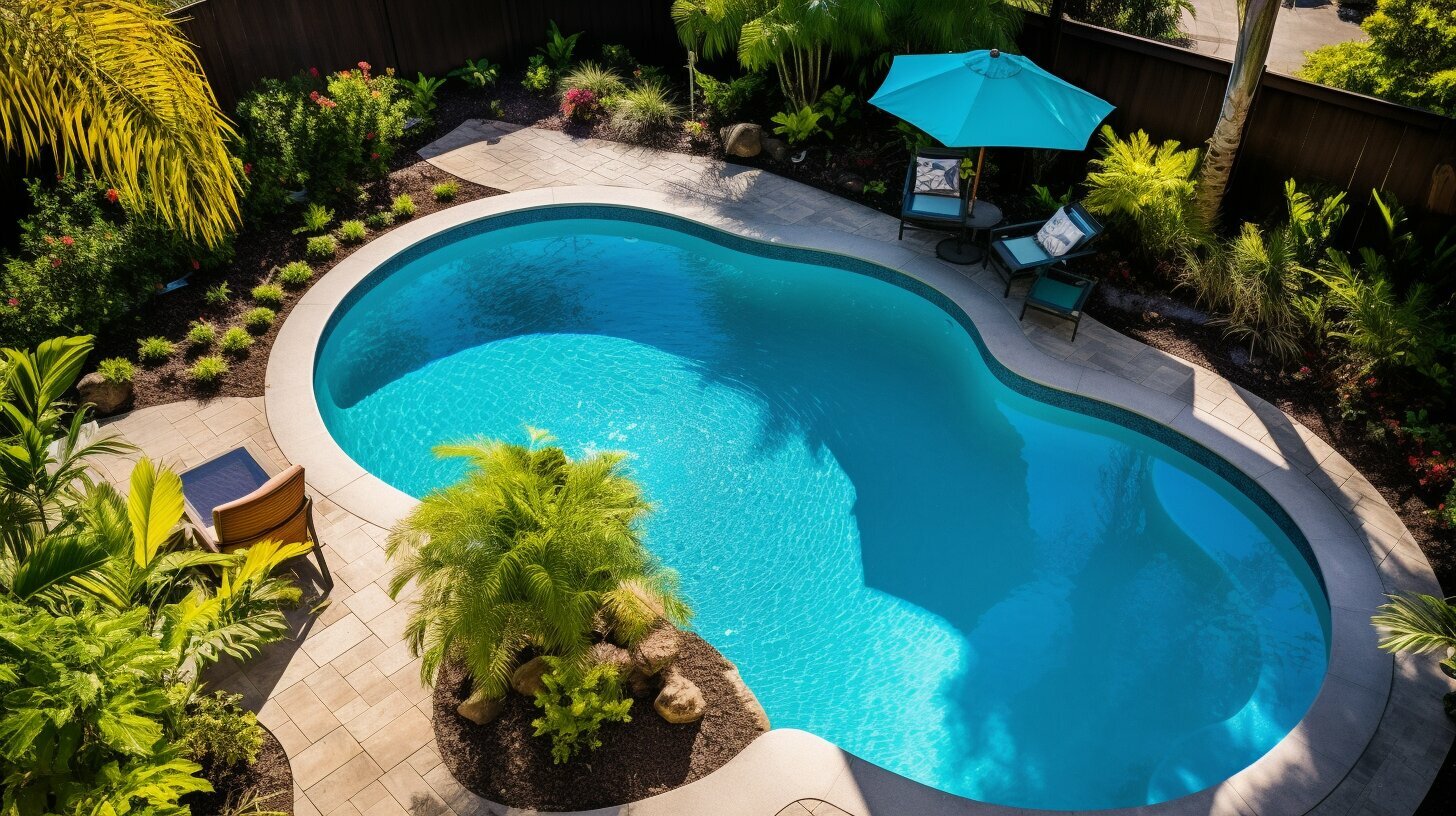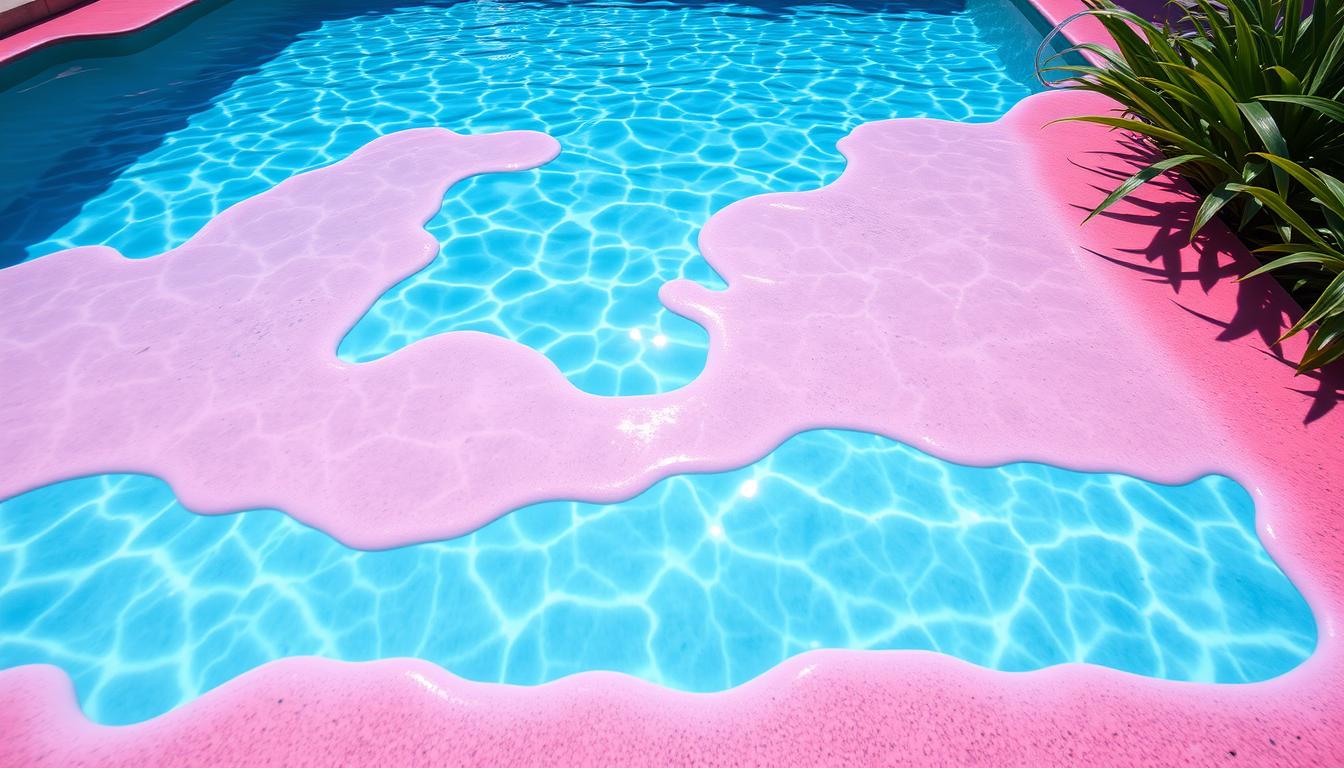
Pink algae, or pink slime, is a bacteria that makes surfaces slippery. It resists chlorine and other pool sanitizers. This stubborn algae spreads quickly, becoming harder to eliminate if left untreated.
Pink algae appears as slimy pink or clear layers on pool surfaces. It sticks to PVC and pool equipment. Proper pool maintenance and water chemistry are key to preventing its growth.
To remove pink algae, focus on brushing and vacuuming regularly. Shock the water and use algaecides designed for pink algae treatment. A powerful pool vacuum can be a valuable tool against pink algae.
The AiDot Enhulk Cordless Pool Vacuum is an excellent choice. It has a max flow rate of 15.8 gallons/min. Its rechargeable batteries provide up to 60 minutes of runtime.
This guide explores pink algae’s causes and identification methods. We’ll discuss best practices for eliminating it from your pool. You’ll learn about regular pool maintenance and proper water chemistry.
We’ll also cover effective cleaning tools to prevent pink algae’s return. By the end, you’ll have strategies to keep your pool pristine and algae-free.
Key Takeaways:
- Pink algae is actually a type of bacteria that can cause surfaces to become slippery and is resistant to chlorine and other sanitizers.
- Poor pool maintenance and water chemistry imbalances contribute to pink algae growth.
- Brushing, vacuuming, shocking the water, and using specific algaecides are essential for eliminating pink algae.
- Maintaining proper water chemistry, particularly pH and chlorine levels, is crucial for preventing pink algae from returning.
- A powerful pool vacuum, like the AiDot Enhulk Cordless Pool Vacuum, can be a valuable tool in keeping your pool clean and algae-free.
What is Pink Algae and Why is it in My Swimming Pool?
Pink algae in your pool can be frustrating. It’s actually a bacteria called Methylobacterium, not true algae. This “pink slime” thrives in areas with poor water flow and low chlorine.
Understanding Pink Algae in Your Pool
Pink algae is a tough bacterium that grows on various pool surfaces. It prefers shadowy corners, crevices, and pool accessories. Unlike green algae, it doesn’t need direct sunlight to grow.
This makes pink algae hard to prevent and eliminate. It can hide in areas that are difficult to reach and clean.
Why Does Pink Algae Happen in Swimming Pools?
Several factors help pink algae grow in pools:
- Poor water circulation, which allows the bacteria to settle and grow in stagnant areas
- Low chlorine levels that are insufficient to prevent or control bacterial growth
- Inadequate pool maintenance, such as infrequent brushing and cleaning of hard-to-reach surfaces
- Unbalanced water chemistry, which can create an environment conducive to bacterial growth
To get rid of pink algae, you need to fix these issues. Regular maintenance and proper water chemistry are key.
Is Pink Algae Dangerous for Swimmers?
Pink algae isn’t directly harmful to humans. However, it can cause problems in your pool:
- Slippery surfaces: Pink algae can create slippery patches on pool surfaces, increasing the risk of accidents and injuries for swimmers.
- Indicator of poor water quality: The growth of pink algae suggests that the pool water is not being properly maintained, which may lead to other health concerns if left unaddressed.
- Aesthetic issues: The presence of pink slime can make the pool appear unsightly and uninviting, detracting from the overall swimming experience.
| Algae Type | Characteristics | Treatment |
|---|---|---|
| Green Algae | Most common type; grows in direct sunlight | Regular brushing, proper chlorine levels, and consistent filtration |
| Mustard Algae | More resistant to chlorine than green algae | Super chlorination and vigorous brushing |
| Black Algae | Most challenging to eradicate; grows on porous surfaces | Aggressive brushing and high dose of pool shock |
| Pink Algae | Resilient bacterium; grows in shadowed areas and crevices | Targeted cleaning, shock treatment, and addressing underlying issues |
Knowing about pink algae helps you keep your pool clean. Take action to fix the problem and maintain a safe swimming environment.
How to Identify Pink Algae Infestation in Your Pool?
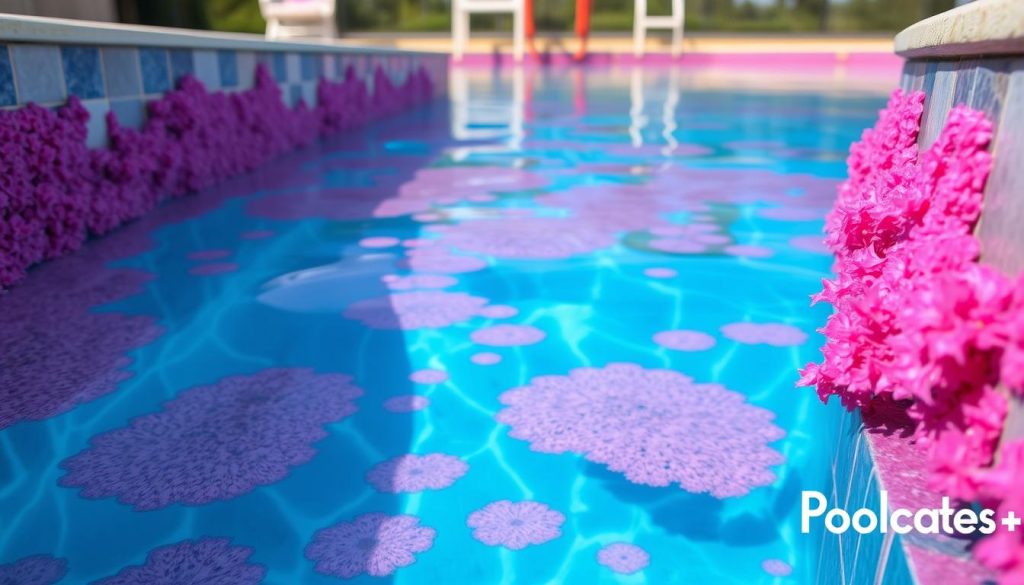
Spotting algae growth early keeps pools clean and safe. Pink algae, though less common, can cause problems if ignored. Let’s explore the signs of pink algae and how to spot it.
Signs of Pink Algae in Your Swimming Pool
Pink algae, or pink slime, is actually a type of bacteria. It thrives in pool environments. Here are some signs of pink algae infestation:
- Slimy, pinkish patches on pool surfaces, particularly in shaded areas or around fixtures
- A distinct, slimy texture that differs from the typical feel of pool surfaces
- Resistance to regular chlorine treatments, requiring more targeted approaches
- Rapid growth and spread, especially in warmer water temperatures between 70°F and 90°F
Differences Between Pink Algae and Other Pool Algae
Pink algae has unique features compared to other pool algae. Here’s a quick comparison:
| Type of Algae | Color | Texture | Resistance to Chlorine | Common Growth Areas |
|---|---|---|---|---|
| Pink Algae | Pinkish or clear | Slimy | High | Shaded areas, crevices, pool fixtures |
| Green Algae | Green | Slimy or fuzzy | Low | Pool walls, floor, and surface |
| Yellow (Mustard) Algae | Yellow or mustard | Powdery or slimy | Moderate | Shaded areas, pool walls, and floor |
| Black Algae | Black or dark green | Rough, roots in surface | Very high | Pool walls, floor, and crevices |
Where to Look for Pink Slime in a Pool
Pink algae likes to hide in hard-to-reach spots. Check these areas often:
- Behind ladders and pool steps
- In crevices and along tile lines
- Around pool fixtures, such as lights and drains
- On the pool floor, particularly in deeper areas
Knowing the signs and hiding spots of pink algae helps catch it early. This knowledge allows for quick action to keep your pool clean and safe.
What are the Best Methods to Get Rid of Pink Algae?
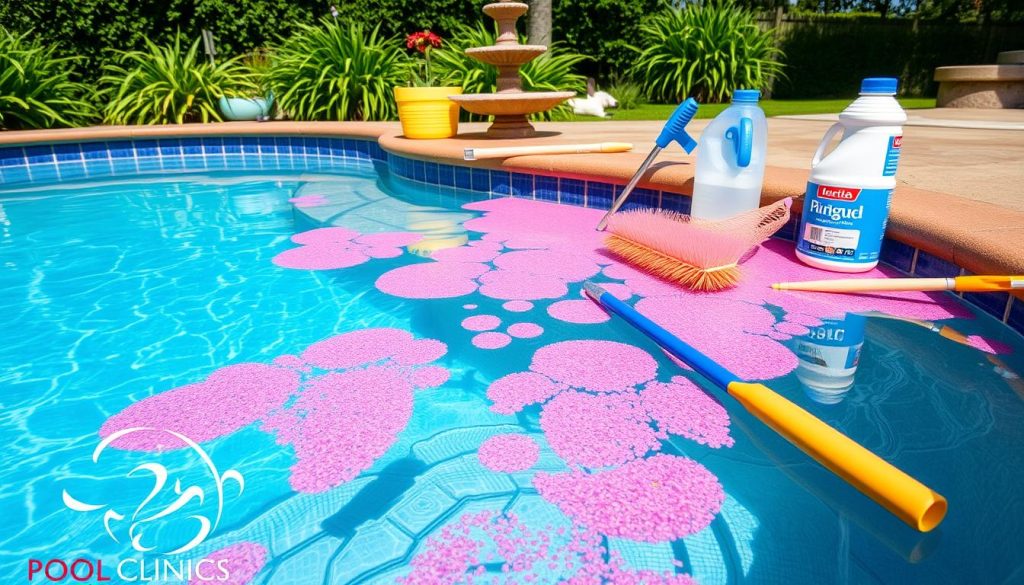
Pink algae can be a stubborn problem in swimming pools. Several effective methods can help eliminate this bacteria and restore your pool’s appearance.
Using Algaecide to Remove Pink Algae
Specialized algaecide products are highly effective against pink algae. Look for products with quaternary ammonium compounds or copper-based ingredients.
These ingredients target the bacteria causing pink algae growth. Follow the manufacturer’s instructions for best results.
To use algaecide effectively, follow these steps:
- Begin by scrubbing the affected areas with a stiff brush to loosen the pink slime.
- Adjust the pool’s pH levels to ensure they are within the recommended range (7.2-7.6).
- Add the algaecide to the pool according to the manufacturer’s instructions, ensuring even distribution throughout the water.
- Run the pool pump continuously for at least 24 hours to allow the algaecide to circulate and work effectively.
- After 24 hours, brush the pool walls and floor again to remove any remaining pink algae.
How to Shock Your Pool Effectively for Pink Algae
Shocking your pool is crucial for eliminating pink algae. It raises chlorine levels to kill bacteria and contaminants.
Before shocking, test and adjust the pool water’s pH to 7.2-7.6. Calculate your pool’s volume to determine the right amount of shock treatment.
- Test the pool water’s pH and adjust it to the recommended range (7.2-7.6) before shocking.
- Calculate the volume of your pool to determine the appropriate amount of shock treatment needed.
- Raise the chlorine levels to at least 10 ppm (parts per million) for optimal results.
- Add the shock treatment to the pool according to the manufacturer’s instructions, distributing it evenly.
- Run the pool pump continuously for at least 24-48 hours to ensure thorough circulation and filtration.
- After shocking, retest the water and adjust the chlorine levels as needed to maintain a consistent range of 1-3 ppm.
Contacting Pink Algae Removal Experts
For severe infestations, consider contacting professional pool maintenance services. They have the expertise to tackle stubborn pink algae growth effectively.
Experts can assess your pool’s condition and identify underlying causes. They can also perform necessary treatments, ensuring the job is done correctly.
When dealing with persistent pink algae issues, consulting with a pool professional can save you time, money, and frustration in the long run.
| Pink Algae Removal Method | Effectiveness | Time Required |
|---|---|---|
| Algaecide Treatment | High | 24-48 hours |
| Pool Shocking | High | 24-48 hours |
| Professional Pool Maintenance Services | Very High | Varies |
Using algaecide, shocking your pool, and seeking expert help can eliminate pink algae. These methods maintain a clean, healthy swimming environment for your family.
How to Prevent Pink Algae from Returning?
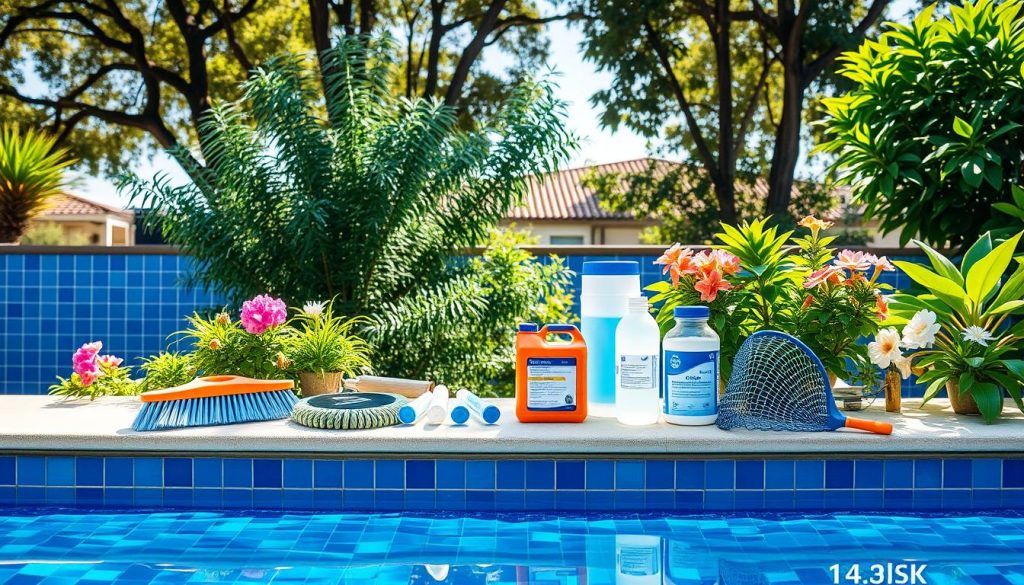
Pink algae can be a nuisance in your pool. But don’t worry! There are ways to keep it at bay. Let’s explore some effective strategies to maintain a clean, healthy pool.
Importance of Regular Pool Maintenance
Consistent pool care is key to preventing pink algae. Brush pool walls and floors regularly. Skim the surface to remove debris. Vacuum the pool to eliminate dirt and organic matter.
These actions create an environment that discourages algae growth. Your family and friends will enjoy a clean, inviting pool all season long.
Water Chemistry and Its Role in Preventing Pink Algae
Proper water chemistry is crucial in algae prevention. Test your pool water often. Keep pH levels between 7.2 and 7.6. Maintain chlorine levels between 1-3 ppm.
Balanced water chemistry creates an environment where algae can’t thrive. Regular testing and adjustments will help keep your pool crystal clear.
| Parameter | Ideal Range | Effect on Pink Algae Prevention |
|---|---|---|
| pH | 7.2 – 7.6 | Maintains chlorine effectiveness and prevents algae growth |
| Chlorine | 1 – 3 ppm | Kills and prevents algae, including pink algae |
| Total Alkalinity | 80 – 120 ppm | Stabilizes pH and prevents rapid fluctuations |
| Calcium Hardness | 200 – 400 ppm | Prevents corrosion and scale formation, maintaining pool health |
Best Practices for Pool Water Movement
Good water circulation helps prevent pink algae growth. Run your pool pump for 8-12 hours daily. This allows water to move through the filtration system properly.
Proper circulation distributes chemicals evenly throughout the pool. It also prevents stagnant areas where algae can grow. Make sure all pool areas get enough water flow.
“An ounce of prevention is worth a pound of cure.” – Benjamin Franklin
Stay on top of your pool care routine. Monitor water chemistry often. Address issues quickly to keep your pool clean and healthy.
With these steps, you’ll reduce the chance of pink algae returning. Your pool will be a refreshing oasis for everyone to enjoy!
What Should I Do if Pink Algae Keeps Coming Back?
Pink algae can be a stubborn problem in pools. But don’t worry! With the right approach, you can beat this issue. Let’s look at common mistakes and solutions.
Common Mistakes in Dealing with Pink Algae
Pink algae may return due to some common errors. These include not brushing the pool well enough and using too little algaecide.
Poor water chemistry and insufficient filter use can also cause problems. By fixing these issues, we can stop pink algae from coming back.
- Not brushing the pool thoroughly enough, especially in hard-to-reach areas where pink algae likes to grow
- Using insufficient amounts of algaecide or not applying it consistently
- Failing to maintain proper water chemistry, particularly pH and chlorine levels
- Not running the pool filter long enough or at the appropriate times
When to Consider a Biguanide Pool Treatment
Sometimes, chlorine-based treatments don’t work against tough pink algae. In these cases, a biguanide pool treatment system might be the answer. Biguanide is a non-chlorine sanitizer that’s gentle on pools and users.
Biguanide pool treatment systems have been shown to be particularly effective against pink algae, which can be resistant to chlorine sanitizers.
Switching to biguanide needs careful planning. It’s best to talk to a pool expert for smooth change and good results.
Consulting Local Pool Professionals for Persistent Issues
If you’ve tried everything and still have pink algae, it’s time to call the experts. Local pool pros can assess your situation and give targeted advice.
A professional pool service can help in many ways. They can inspect your pool, find issues, and suggest the best treatments.
- Thoroughly inspect your pool and identify any underlying issues contributing to algae growth
- Recommend and apply the most effective treatments for your specific case
- Provide ongoing maintenance and support to prevent future algae outbreaks
Don’t hesitate to ask for help with stubborn pink algae. A skilled pro can restore your pool and ensure worry-free swimming.
FAQ
How can I get rid of pink slime in my pool?
Start by balancing the water chemistry. Focus on pH and chlorine levels. Brush affected areas and use a specialized algaecide. Run your pool filter for at least 24 hours after treatment. This will help clear the water effectively.
What causes pink algae growth in swimming pools?
Pink algae is actually bacteria. It thrives in warm water with poor circulation and low chlorine. Contaminated equipment or swimmers can introduce it. Proper water chemistry and circulation are key to prevention. Regular maintenance helps keep pink algae at bay.
Can I use a chlorine pool to prevent pink algae?
Yes, proper chlorine levels help prevent pink algae growth. Keep chlorine between 1-3 ppm. Shock the pool regularly to eliminate bacteria.
How often should I clean my pool to avoid pink algae?
Clean your pool walls and floor weekly. Vacuum as needed to remove debris. Test and adjust water chemistry every week.
Consider using an algaecide for prevention. Regular maintenance is crucial in avoiding pink algae growth.
What should I do if I see pink algae in my pool?
Act quickly to prevent spreading. Brush affected areas and balance water chemistry. Use a specialized algaecide and run the filter continuously.
Consider shocking the pool to eliminate bacteria. If the problem persists, consult a professional pool service.
Are there any specific products to treat pink algae in pools?
Yes, algaecides targeting pink algae are available. Look for products with quaternary ammonium compounds or polyquaternium. These are effective in eliminating pink algae.
Always follow the manufacturer’s instructions for application and dosage. Proper use ensures the best results.
Can pink algae affect the pool fixtures?
Pink algae can grow on pool surfaces and fixtures. It may cause staining and damage if left untreated. Regular cleaning helps prevent pink algae from affecting fixtures.
Is it safe to swim in a pool with pink algae?
Avoid swimming in pools with visible pink algae. While not directly harmful, it indicates poor water quality. Other bacteria may be present, causing potential health issues.
How can I prevent pink algae from forming in my pool?
Maintain proper water chemistry, especially pH and chlorine levels. Brush and vacuum regularly. Ensure adequate water circulation throughout the pool.
Use an algaecide for prevention. Address any signs of pink algae quickly to stop it from spreading.






